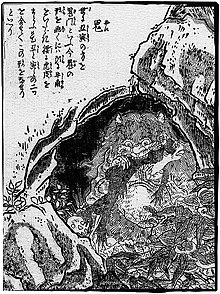Oni



Oni ( Japanese 鬼 ) are yōkai from Japanese mythology . The idea ranges from the simple, neutral spirit of a deceased to grimly stupid ogre-like fiends to deeply evil merciless demons.
Appearance
Iconographically, Oni go back to the Indian Rakshasa . They are usually depicted as ugly giant creatures with sharp claws, wild hair and one or two horns on their heads. Mostly they are human-like, but sometimes they have an odd number of eyes or extra fingers and toes. Their skin is any color, but is usually red, blue, or green. Their grim appearance is supported by a loincloth made of tiger skins and iron-reinforced clubs ( 金 棒 , kanabō ) that they wear. This image led to the expression Oni ni Kanabō ( 鬼 に 金 棒 ), literally: "an oni with an iron club", which means "invincible".
Origin and behavior
While their appearance was borrowed from the Indian Rakshasa, the character comes from Chinese, which means "spirits of the deceased" (Chinese gui ).
Already in the Heian period they were portrayed as cannibals and general opponents of humans or devils. The Nihon Ryōiki names incidents in which mono (also written 鬼 ) drove people insane. They are described as the spirits of the deceased who were bitter or malevolent during their lifetime and who now curse the living. Jealous women who became such Oni were called Hannya ( 般若 ). Other descriptions, taken from Chinese mythology, saw them as inhabitants of hell, such as the two hell guardians Gozu ( 牛頭 'cattle head' ) and Mezu ( 馬頭 'horse head' ).
A well-known tale of Oni as an ogre can be found in Shuten Dōji , who was up to mischief near the capital Heian-kyō until he was slain by Minamoto no Yorimitsu .
Since the 10th century, Oni have been strongly associated with the Northeast ( 鬼 門 kimon , German 'Oni gate' ), especially in the Yin-Yang tradition. Temples are often built in this direction, and Japanese buildings sometimes have L-shaped indentations to the northeast to ward off oni; Enryaku-ji on Mount Hiei northeast of downtown Kyōto and Kanei-ji in the same direction from Edo Castle are examples. The Japanese capital itself moved from Nagaoka-kyō northeast to Heian-kyō (Kyōto) in the 8th century .
From the 13th century on, however, there are also descriptions of rather clumsy Oni. This weakening of the malevolent continued over time, so that they are rather comically portrayed on the Ukiyo-e cuts of the Edo period .
Especially in the spring, some villages hold annual ceremonies to scare away Oni. During the Setsubun Festival, people throw soybeans out of their homes and shout Oni wa soto! Fuku wa uchi! ( 鬼 は 外! 福 は 内 ! , demons out, happiness in! ). Monkey statues are also seen as protectors from Oni, as the Japanese word for monkey saru is the same as that for "abandoned".
Contrary to the malicious nature, there are also positive depictions of Oni. Japanese buildings sometimes have "oni-faced roof tiles" ( 鬼 瓦 , onigawara ), which are also believed to keep bad luck out, similar to the gargoyles in the west. At the Hanamatsuri (flower festival) in Shidara , dancers ( Sakaki-oni ) disguised as oni perform , who distribute blessings with their dance and ward off evil spirits. In Akita Prefecture, there is again a custom called Namahage , in which the visit of Kami ( raihōshin ) from the mountains is imitated, who are supposed to ward off evil spirits, among other things, whereby these Kami here resemble Oni in their appearance.
Catching is the Oni's favorite game, and so in the Japanese version the player whose turn it is is called Oni (this also applies to hide and seek).
Individual evidence
- ↑ Term "Oni (鬼 / お に)", (English / Japanese): [1] on tangorin.com, accessed on March 20, 2018 - online
- ^ Term "Oni (鬼 / お に)", (German / Japanese): [2] on wadoku.de, accessed on March 20, 2018 - Online
- ↑ a b c d e Oni and kappa . In: Religion-in-Japan: A Web Handbook. University of Vienna. Bernhard Scheid, September 3, 2018, accessed on June 21, 2019 .
- ↑ a b c Kawamura Kunimitsu: "Oni" . In: Encyclopedia of Shinto. Kokugaku-in , March 13, 2005 (English)
Web links
- Noriko T. Reider, Transformation of the Oni: From the Frightening and Diabolical to the Cute and Sexy. , in: Asian Folklore Studies , 2003, 62/1, pp. 133-57 (PDF file, 877.9 kB; English)